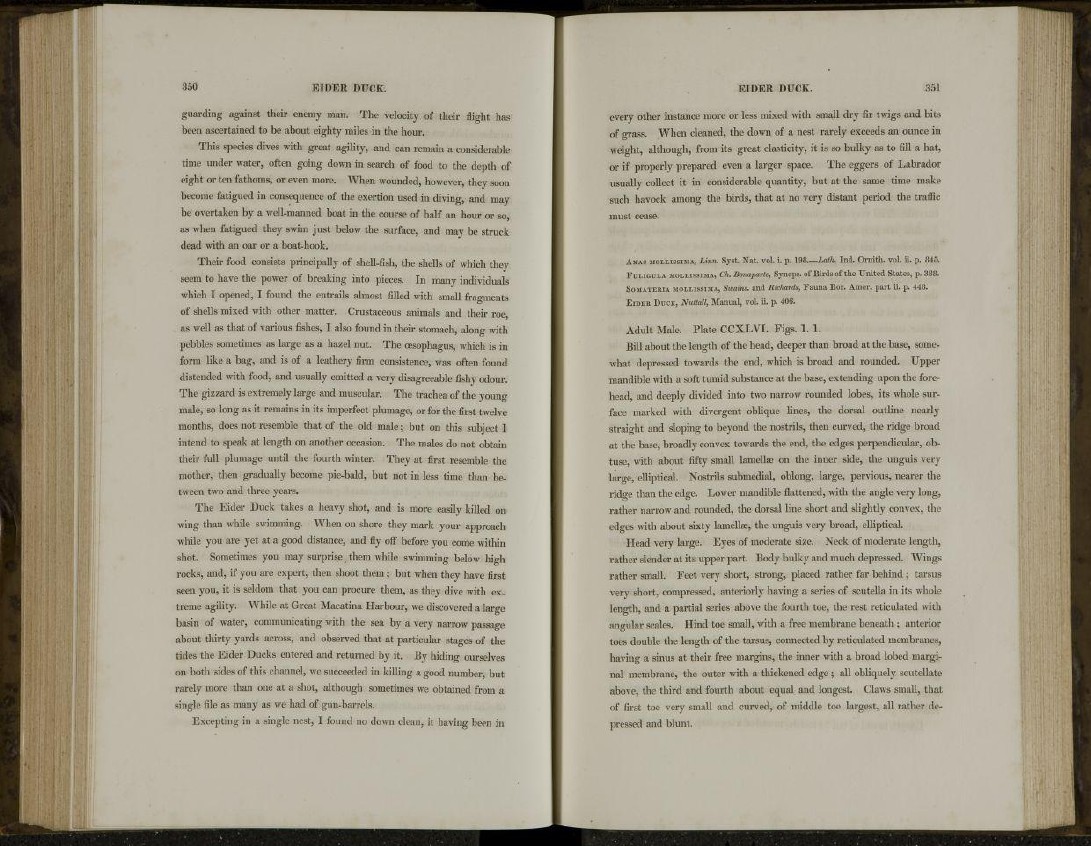
guarding against their enemy man. The velocity of their flight has
been ascertained to be about eighty miles in the hour.
This species dives with great agility, and can remain a considerable
time under water, often going down in search of food to the depth of
eight or ten fathoms, or even more. When wounded, however, they soon
become fatigued in consequence of the exertion used in diving, and may
be overtaken by a well-manned boat in the course of half an hour or so,
as when fatigued they swim just below the surface, and may be struck
dead with an oar or a boat-hook.
Their food consists principally of shell-fish, the shells of which they
seem to have the power of breaking into pieces. In many individuals
which I opened, I found the entrails almost filled with small fragments
of shells mixed with other matter. Crustaceous animals and their roe,
as well as that of various fishes, I also found in their stomach, along with
pebbles sometimes as large as a hazel nut. The oesophagus, which is in
form like a bag, and is of a leathery firm consistence, was often found
distended with food, and usually emitted a very disagreeable fishy odour.
The gizzard is extremely large and muscular. The trachea of the young
male, so long as it remains in its imperfect plumage, or for the first twelve
months, does not resemble that of the old male; but on this subject I
intend to speak at length on another occasion. The males do not obtain
their full plumage until the fourth winter. They at first resemble the
mother, then gradually become pie-bald, but not in less time than between
two and three years.
The Eider Duck takes a heavy shot, and is more easily killed on
wing than while swimming. When on shore they mark your approach
while you are yet at a good distance, and fly off before you come within
shot. Sometimes you may surprise them while swimming below high
rocks, and, if you are expert, then shoot them; but when they have first
seen you, it is seldom that you can procure them, as they dive with extreme
agility. While at Great Macatina Harbour, we discovered a large
basin of water, communicating with the sea by a very narrow passage
about thirty yards across, and observed that at particular stages of the
tides the Eider Ducks entered and returned by it. By hiding ourselves
on both sides of this channel, we succeeded in killing a good number, but
rarely more than one at a shot, although sometimes we obtained from a
single file as many as we had of gun-barrels.
Excepting in a single nest, I found no down clean, it having been in
every other instance more or less mixed with small dry fir twigs and bits
of grass. When cleaned, the down of a nest rarely exceeds an ounce in
weight, although, from its great elasticity, it is so bulky as to fill a hat,
or if properly prepared even a larger space. The eggers of Labrador
usually collect it in considerable quantity, but at the same time make
such havock among the birds, that at no very distant period the traffic
must cease.
ANAS MOELISSIMA, Linn. Syst. Nat. vol. i. p. 198.—Lath. Ind. Ornith. vol. ii. p. »45.
FULIGULA MOLLISSIMA, Ch. Bonaparte, Synops. of Birds of the United States, p. 388.
So MATERIA MOLLISSIMA, Swains, and Richards, Fauna Bor. Amer. part ii. p. 448.
EIDER DUCK, Nuttall, Manual, vol. ii. p. 406.
Adult Male. Plate CCXLVI. Figs. 1. 1.
Bill about the length of the head, deeper than broad at the base, somewhat
depressed towards the end, which is broad and rounded. Upper
mandible with a soft tumid substance at the base, extending upon the forehead,
and deeply divided into two narrow rounded lobes, its whole surface
marked with divergent oblique lines, the dorsal outline nearly
straight and sloping to beyond the nostrils, then curved, the ridge broad
at the base, broadly convex towards the end, the edges perpendicular, obtuse,
with about fifty small lamellae on the inner side, the unguis very
large, elliptical. Nostrils submedial, oblong, large, pervious, nearer the
ridge than the edge. Lower mandible flattened, with the angle very long,
rather narrow and rounded, the dorsal line short and slightly convex, the
edges with about sixty lamella?, the unguis very broad, elliptical.
Head very large. Eyes of moderate size. Neck of moderate length,
rather slender at its upper part. Body bulky and much depressed. Wings
rather small. Feet very short, strong, placed rather far behind ; tarsus
very short, compressed, anteriorly having a series of scutella in its whole
length, and a partial series above the fourth toe, the rest reticulated with
angular scales. Hind toe small, with a free membrane beneath ; anterior
toes double the length of the tarsus, connected by reticulated membranes,
having a sinus at their free margins, the inner with a broad lobed marginal
membrane, the outer with a thickened edge ; all obliquely scutellate
above, the third and fourth about equal and longest. Claws small, that
of first toe very small and curved, of middle toe largest, all rather depressed
and blunt.